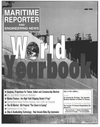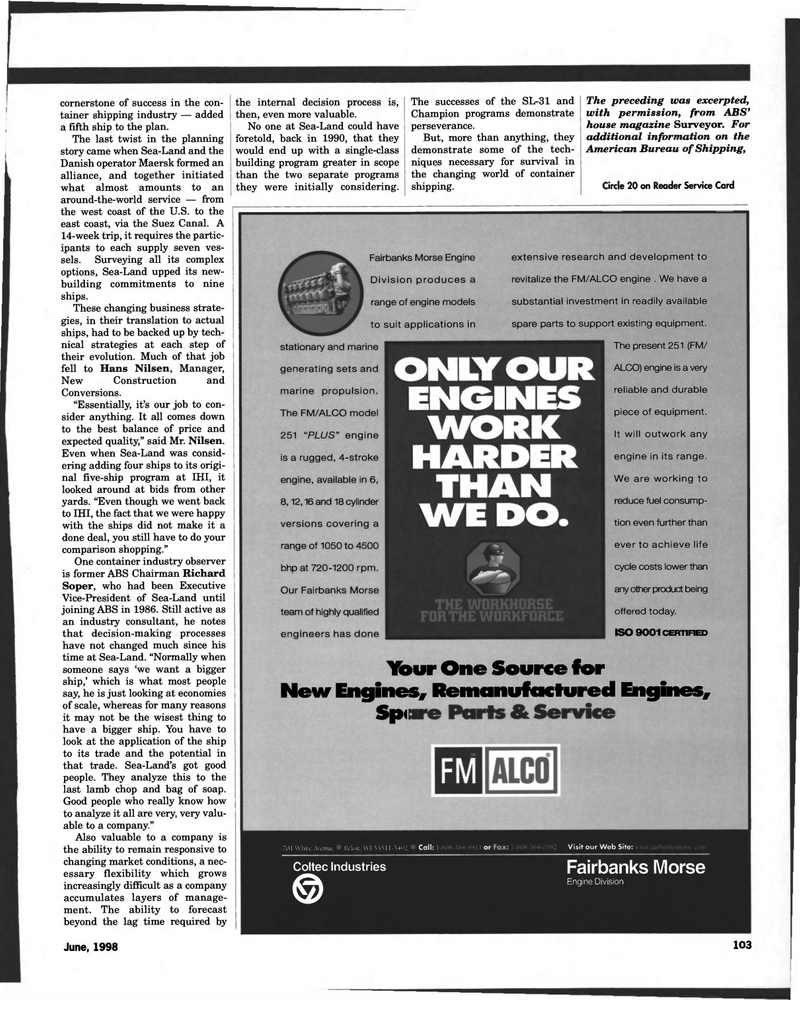
Page 101: of Maritime Reporter Magazine (June 1998)
Read this page in Pdf, Flash or Html5 edition of June 1998 Maritime Reporter Magazine
cornerstone of success in the con- tainer shipping industry — added a fifth ship to the plan.
The last twist in the planning story came when Sea-Land and the
Danish operator Maersk formed an alliance, and together initiated what almost amounts to an around-the-world service — from the west coast of the U.S. to the east coast, via the Suez Canal. A 14-week trip, it requires the partic- ipants to each supply seven ves- sels. Surveying all its complex options, Sea-Land upped its new- building commitments to nine ships.
These changing business strate- gies, in their translation to actual ships, had to be backed up by tech- nical strategies at each step of their evolution. Much of that job fell to Hans Nilsen, Manager,
New Construction and
Conversions. "Essentially, it's our job to con- sider anything. It all comes down to the best balance of price and expected quality," said Mr. Nilsen.
Even when Sea-Land was consid- ering adding four ships to its origi- nal five-ship program at IHI, it looked around at bids from other yards. "Even though we went back to IHI, the fact that we were happy with the ships did not make it a done deal, you still have to do your comparison shopping."
One container industry observer is former ABS Chairman Richard
Soper, who had been Executive
Vice-President of Sea-Land until joining ABS in 1986. Still active as an industry consultant, he notes that decision-making processes have not changed much since his time at Sea-Land. "Normally when someone says 'we want a bigger ship,' which is what most people say, he is just looking at economies of scale, whereas for many reasons it may not be the wisest thing to have a bigger ship. You have to look at the application of the ship to its trade and the potential in that trade. Sea-Land's got good people. They analyze this to the last lamb chop and bag of soap.
Good people who really know how to analyze it all are very, very valu- able to a company."
Also valuable to a company is the ability to remain responsive to changing market conditions, a nec- essary flexibility which grows increasingly difficult as a company accumulates layers of manage- ment. The ability to forecast beyond the lag time required by the internal decision process is, then, even more valuable.
No one at Sea-Land could have foretold, back in 1990, that they would end up with a single-class building program greater in scope than the two separate programs they were initially considering.
The successes of the SL-31 and
Champion programs demonstrate perseverance.
But, more than anything, they demonstrate some of the tech- niques necessary for survival in the changing world of container shipping.
The preceding was excerpted, with permission, from ABS' house magazine Surveyor. For additional information on the
American Bureau of Shipping,
Circle 20 on Reader Service Card
Fairbanks Morse Engine
Division produces a range of engine models to suit applications in stationary and marine generating sets and marine propulsion.
The FM/ALCO model 251 "PLUS" engine is a rugged, 4-stroke engine, available in 6, 8,12,16 and 18 cylinder versions covering a range of 1050 to 4500 bhp at 720-1200 rpm.
Our Fairbanks Morse team of highly qualified engineers has done extensive research and development to revitalize the FM/ALCO engine . We have a substantial investment in readily available spare parts to support existing equipment.
The present 251 (FM/
ALCO) engine is a very reliable and durable piece of equipment.
It will outwork any engine in its range.
We are working to reduce fuel consump- tion even further than ever to achieve life cycle costs lower than any other product being offered today.
ISO 9001 CERTIFIED
Kbur One Source for
New Engines, Remanuf actured Engines,
Spi 701 While Avenue • Beloil. WI 5351 1-5492 • Call: 1
Coltec Industries
Visit our Web Site: @ Fairbanks Morse Engine Division
June, 1998 103

 100
100

 102
102
